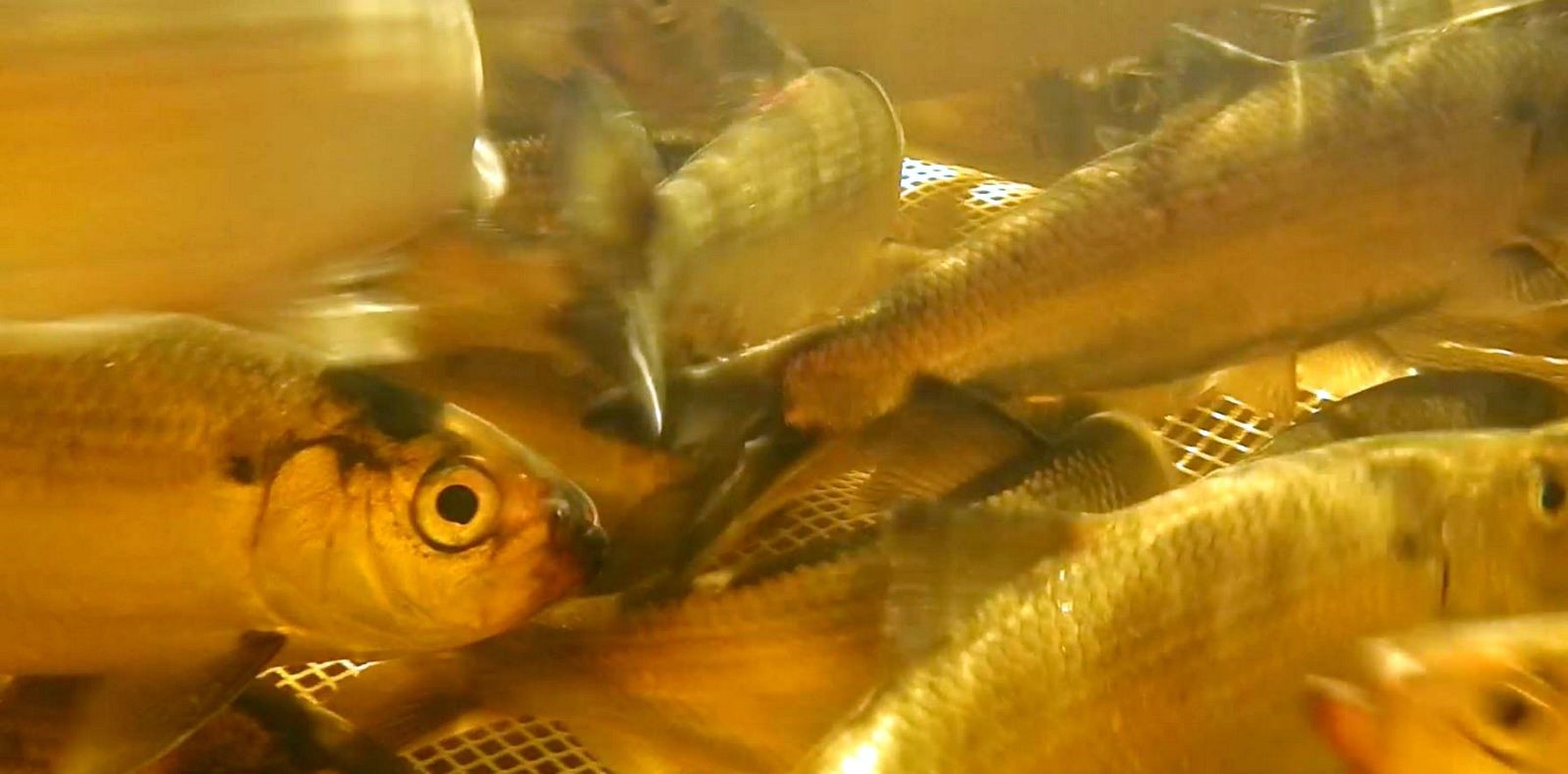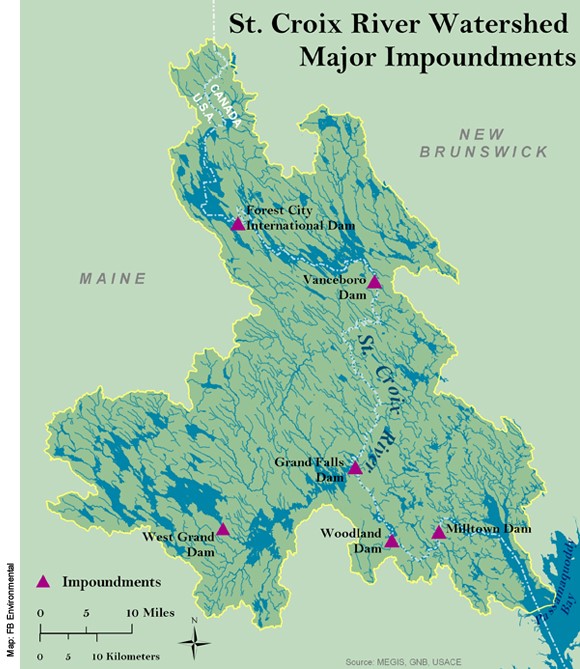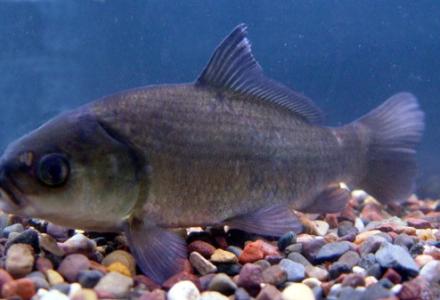
One fish told another fish, and now alewives are returning to the St. Croix River.
This year, more than 93,000 of the fish were counted entering the river at Milltown Dam in New Brunswick. That’s the most since 1998, when about 177,000 were counted. But populations of alewives still have a long way to go on the river. And this year’s high numbers aren’t a simple result of the river being reopened.
The St. Croix River forms part of the Canadian-U.S. border between New Brunswick and Maine. It was re-opened to alewives in 2013 after being closed for 18 years.

The government of Maine blocked the river in 1995 to prevent alewives from migrating to their spawning grounds, due to fears that the native fish were harming populations of smallmouth bass. Studies showed that was not the case, and Maine legislators voted in April 2013 to remove the last of the state barriers in the St. Croix, at the Woodland and Grand Falls dams.
The alewife, also known as gaspereau, generally return to the river to spawn every three or four years, said Abby Pond, former executive director of the St. Croix International Waterway Commission and project manager of the Milltown fish count.
“The river was reopened in time for the 2013 run,” Pond explained. “… We’re looking at probably slow increases for the next three years, and then if the fish are getting to new habitat, we’ll start to see real increases after 2016 or 2017.”

What’s Behind the Increase?
Graham Chafe is a biologist with the Atlantic Salmon Federation in St. Andrews, New Brunswick, about 20 minutes from Milltown.
Chafe explains that runs of alewives had been dropping since 1996. Annual counts of more than 600,000 were common in past decades, but had decreased to 25,000 or less by 1999, and just 900 fish in 2002.
He surmises that this year’s high count was partly the result of a higher run of about 50,000 fish in 2010, and possibly a high rate of survival at sea.
Pond says a good runoff in 2014 also helped with spring flow, aiding movement of alewives into the river. Fishway engineers from Canada and the U.S. made adjustments to the fish ladder at Milltown this year as well.
Having more fish return to the system, with new habitat to access, is a major plus.
“Before 2013, when they opened the whole river, less than 2 percent of the potential production area for alewives was available to them,” Chafe explained. “They were closed off to all of these upstream areas.”
Now that the river has been reopened, alewives will move out through the system, but it will take time for that to happen, Chafe said. It’s important to continue the counts at Milltown to track the success of the restoration effort.
How Far Do They Swim?
One mystery is how many of the fish counted at Milltown are making it farther up the river, through fishways at other dams. Researchers are using tracking devices to get a better idea.
In June 2014, the Federation implanted tracking devices in 30 alewives entering St. Croix at Milltown, then released the fish a half mile upstream at a boat launch.
Four of the fish made it past the Woodland Dam, which wasn’t accessible prior to 2013. Three of those four went even farther, and at least one of them went 16 kilometers (almost 10 miles), past the Grand Falls Dam. The study was repeated this year, but results are still being tabulated.
“It suggests that they are passing all the dams that are open to them,” he said. “They are spreading out throughout the system. They are accessing that increased habitat. We’re likely to see more strong runs in the future and that’s exciting.”

The Passamaquoddy Tribe is conducting similar tracking work, including what alewives are doing in the estuary and bay and how they behave around Milltown Dam.
“The alewives are one of many species that the Tribe relies on for sustenance,” said Theo Willis, an ecologist with the Passamaquoddy-Pleasant Point Environmental Department.
“It’s a culturally important species to the Tribe, so seeing the restoration of alewives is important both on an ecological and a spiritual level.”

Shad and Mussels, Too
In 2014, about 27,000 alewives were counted at Milltown, about 66,000 fewer than this year. The counts are done near the head of the river, which splits St. Stephen, New Brunswick, and Calais, Maine.
A trap there is monitored daily, and the fish are counted by hand, then released. The counts continue from about April through June of each year, based on when the fish are moving into the river.
Among the high number of alewives counted this year were 11 American shad, marking the first time that species has been reported at Milltown since 1999.
“We think these were coming into the bay with a group of alewives and got caught up in the run,” Pond said. “… They were probably heading for the Saint John River (to the north) or other places with known shad runs.”
But seeing shad is a positive signal of biodiversity, she said.
Chafe said the return of alewives to the St. Croix benefits the ecosystem as a whole.
“The alewife are a prey species for other fish, and the only known host of a type of beneficial, native mussel in the river” known as the alewife floater,” he said.
The counts at Milltown are supported in part through the IJC’s International Watersheds Initiative project, funded by Canada and the United States. In-kind support is provided by the St. Croix International Waterway Commission, the Passamaquoddy Tribe and the Atlantic Salmon Federation, along with the Maine Department of Marine Resources, NB Power Corp., Canada’s Department of Fisheries and Oceans, and the U.S. Fish and Wildlife Service.





